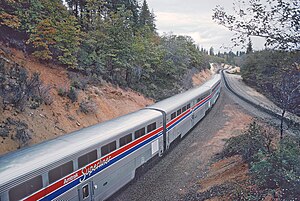Superliner (railcar)
| Superliner | |
|---|---|

Superliner I cars on the San Francisco Zephyr in November 1980
|
|

Interior of a Superliner I Sightseer lounge
|
|
| Manufacturer |
|
| Constructed |
|
| Entered service | 1979 |
| Number built | 479 |
| Operator(s) | Amtrak |
| Line(s) served | Auto Train, California Zephyr, Capitol Limited, City of New Orleans, Coast Starlight, Empire Builder, Heartland Flyer, Pere Marquette, Southwest Chief, Sunset Limited, and Texas Eagle |
| Specifications | |
| Car length | 85 ft 0 in (25.91 m) |
| Width | 10 ft 2 in (3.10 m) |
| Height | 16 ft 2 in (4.93 m) |
| Entry | Step |
| Doors | 1 |
| Maximum speed | 100 mph (160 km/h) |
| Weight | 157,000–174,000 lb (71,214–78,925 kg) |
| Power supply | Head-end power |
| Bogies |
|
| Braking system(s) | Air |
| Track gauge | 4 ft 8 1⁄2 in (1,435 mm) |
The Superliner is a type of bilevel intercity railroad passenger car used by Amtrak. Pullman-Standard built the first cars, known as Superliner I, in 1975–1981; Bombardier Transportation built a second batch, the Superliner II, in 1991–1996. The design descends from the Budd Hi-Level, employed by the Santa Fe on its El Capitan. Car types include coaches, dining cars, lounges, and sleeping cars.
The first Superliners entered service in February 1979. Amtrak employs the Superliners on all its Western and some Eastern long-distance routes; tunnel clearances prevent their use on the Northeast Corridor. Superliner coaches can also be found on short-distance corridor services. Derivative designs such as the California Car and Surfliner are used in California.
Amtrak assumed control of almost all private sector intercity passenger rail service in the United States on May 1, 1971, with a mandate to reverse decades of decline. Amtrak retained approximately 184 of the 440 trains which had run the day before. To operate these trains, Amtrak inherited a fleet of 300 locomotives (electric and diesel) and 1190 passenger cars, most of which dated from the 1940s–1950s. No new sleeping cars had been built for service in the United States since the mid-1950s.
Amtrak employed a mix of inherited cars on its long-distance trains in the Western United States. Most these were conventional single-level, but Amtrak had also inherited 73 Hi-Levels from the Santa Fe. The Budd Company built these between 1954–1964; the bilevel design was well-suited to the long distances in the west. When Amtrak issued a request for proposal (RFP) in 1973 for a "totally new" passenger car it "was assumed" that the design would be bilevel. Thirteen companies responded to the RFP; Amtrak selected the proposal by Louis T. Klauder & Associates. The design was finished by mid-1974 and Amtrak invited four companies to bid on its construction: Boeing, Budd, Pullman-Standard, and Rohr, with Pullman-Standard winning the contract.
...
Wikipedia
